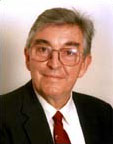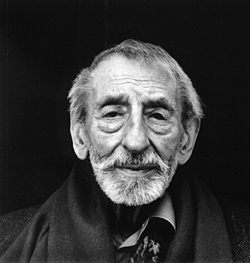 |
→ May 2005 Contents → Column
|
Farewell, Fritz
|
 |
|||
|
He was the German Pope of Photography - one of the great personalities of photography in the 20th century.
Professor Dr. Fritz Gruber died in Cologne on March 31, 2005 at the wonderful age of 96 years.
Fritz Gruber achieved international fame when he co-founded Photokina in 1950, when the city of Cologne was still in ruins five years after the end of World War II.
He remained in charge of Photokina's photography exhibitions until 1980.
Leo Fritz Gruber was born on June 7th, 1908, in Cologne. Initially he wanted to be a painter; however, he soon recognized that he was not talented enough. At the University of Cologne he studied a cocktail of philosophy, German literature, history of the arts, theatre, journalism, ethnology and languages.
In the 1930s Fritz Gruber worked as editor and publisher of a newspaper which was closed down by the Nazis. In 1933, when Hitler came to power, Gruber emigrated to London. After the war he worked as the official photographer at the British occupation forces' headquarters and as a portrait photographer. His involvement with the creation of Photokina began in 1949. In 1951 he became a founding member of the German Society of Photography (DGPh - Deutsche Gesellschaft fur Photographie).
Fritz Gruber was a photographer, curator, author, publisher and a passionate collector of photography. He has been credited with the inclusion of the history of photography into the academic curriculum as part of art history studies at German universities since 1973.
Gruber, the curator, created more than 300 international photo exhibitions. At each Photokina he made certain that photography as a news medium, as documentation and as an art was not crowded out in the photographic marketplace. For his picture shows he often selected young, unknown photographers and thus started many careers. Among his first exhibitions in 1951 was a large retrospective of August Sander, by then almost forgotten. He did not fail to let Edward Steichen, then the Director of Photography at New York's Museum of Modern Art, know of his exhibition. As a result, Steichen included August Sander portraits in his legendary project "The Family of Man." Gruber always considered himself a kind of wheeler-dealer.
Starting off with an August Sander exhibition so early after the war was no accident: Already in his school days Fritz Gruber had started to collect photographs. His first serious collector's item came from the then-famous photographer Sander, whose son was one of Fritz's schoolmates. It was a picture showing his high school teacher. The Fritz and Renate Gruber Collection can be seen since 1971 at the Museum Ludwig, right next to the Cologne cathedral. Since then, hundreds of photographers have been guests of Fritz and Renate Gruber at their villa in Cologne. Some dropped in for a late breakfast (which Fritz often initiated with a large glass of red Bordeaux); others stayed as houseguests. Many left samples of their work behind as token thank-yous. Most gifts were added to the Gruber Collection, which thus grew from 800 items in 1971 to over 3,000 today, a lively mix of photography history and the 50 years during which Mr. Photokina ruled and held court from Cologne.
Fritz Gruber, the author and publicist, began in 1929, when he wrote about "Photography as a Passion" in a Cologne newspaper. After the war he published books of photographs of Konrad Adenauer, the first German chancellor (1955), famous personalities (1960) and "Portrait of Man Ray" (1963). In 1964 he published the anthology "Great Photographers of Our Century" which has become a classic on photography. The countless articles in German and international newspapers and magazine have yet to be assembled. One of many television documentaries on Fritz Gruber was titled "The Pressphoto: Stronger than Words."
Fritz Gruber never retired. The German Society of Photography made him an honorary president in 1984 and he remained active for them until early 2005. In 2004 he attended the opening of the last round of photo exhibitions at Photokina and met daily with old and new friends from the world of photography at his home, always impeccably dressed in his own, old-world style, witty, always interested in new ideas and new talents, always the classic gentleman.
Fritz Gruber was married since 1959 to the 31-year-younger Renate Busch. Fritz and Renate, despite their difference in age, always seemed a happy couple. Renate shared all his interests, knew all his friends. During the last years Renate was always at Fritz Gruber's side, but she would never hold him back from an exhibition visit, or send a guest on his way to give Fritz a rest. Until his end, his home remained a meeting place for the international photo scene of the famous and young talents.
On April 19, more than 250 friends and road companions assembled in the Cologne Museum Ludwig to say good-bye to Fritz Gruber. A jazz trio played between eulogies. The fellow German collector Dr. Wilfried Wiegand called him a grandsigneur: "A man like him isn't easy to be found anymore. He was a man who managed to speak to and link several generations."
Tribute contributed by Horst Faas, with information provided by Michael Ebert (Hilden, Germany)
© Horst Faas
The Digital Journalist Editor for Europe
|
||||
Back to May 2005 Contents
|
|
